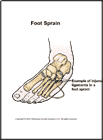
Foot Sprain
What is a foot sprain?
A foot sprain is an injury that causes a stretch or tear in one or more ligaments in the foot. Ligaments are strong bands of tissue that connect bones to bones.
How does it occur?
A foot sprain occurs by twisting or bending the foot. This can happen if you stumble on an uneven surface, land awkwardly from a jump, or from kicking an object that doesn't move easily.
What are the symptoms?
Pain, swelling, and tenderness in the foot. You may have difficulty walking.
How is it diagnosed?
Your health care provider will review your symptoms, ask how you injured your foot, and examine you. Your provider may want to get an x-ray of your foot. The x-ray will be normal if you have a sprain.
How is it treated?
Treatment may include:
- Applying ice packs to your foot for 20 to 30 minutes every 3 to 4 hours for the first 2 to 3 days or until the pain goes away. Thereafter, icing your foot at least once a day until the other symptoms are gone.
- Elevating your foot by placing a pillow underneath it. Try to keep your foot above the level of your heart.
- Wrapping an elastic bandage around your foot to keep the swelling from getting worse.
- Using crutches until you can walk without pain.
- Taking anti-inflammatory medication or other pain medication prescribed by your provider.
- Doing foot exercises to improve your foot strength and range of motion. The exercises will help you return to your normal activity or sports.
When can I return to my sport or activity?
The goal of rehabilitation is to return you to your sport or activity as soon as is safely possible. If you return too soon you may worsen your injury, which could lead to permanent damage. Everyone recovers from injury at a different rate. Return to your sport or activity will be determined by how soon your foot recovers, not by how many days or weeks it has been since your injury occurred. In general, the longer you have symptoms before you start treatment, the longer it will take to get better.
You may safely return to your sport or activity when, starting from the top of the list and progressing to the end, each of the following is true:
- You have full range of motion in the injured foot compared to the uninjured foot.
- You have full strength of the injured foot compared to the uninjured foot.
- You can jog straight ahead without pain or limping.
- You can spring straight ahead without pain or limping.
- You can do 45° cuts, first at half-speed, then at full-speed.
- You can do 20-yard figures-of-eight, first at half-speed, then at full-speed.
- You can do 90° cuts, first at half-speed, then at full-speed.
- You can do 10-yard figures-of-eight first at half-speed, then at full-speed.
- You can jump on both legs without pain and you can jump on the injured leg without pain.
How can I prevent a foot sprain?
Unfortunately, most foot sprains occur during accidents that are not preventable. However, it is important to wear proper fitting footwear and to avoid running or playing on uneven surfaces.

